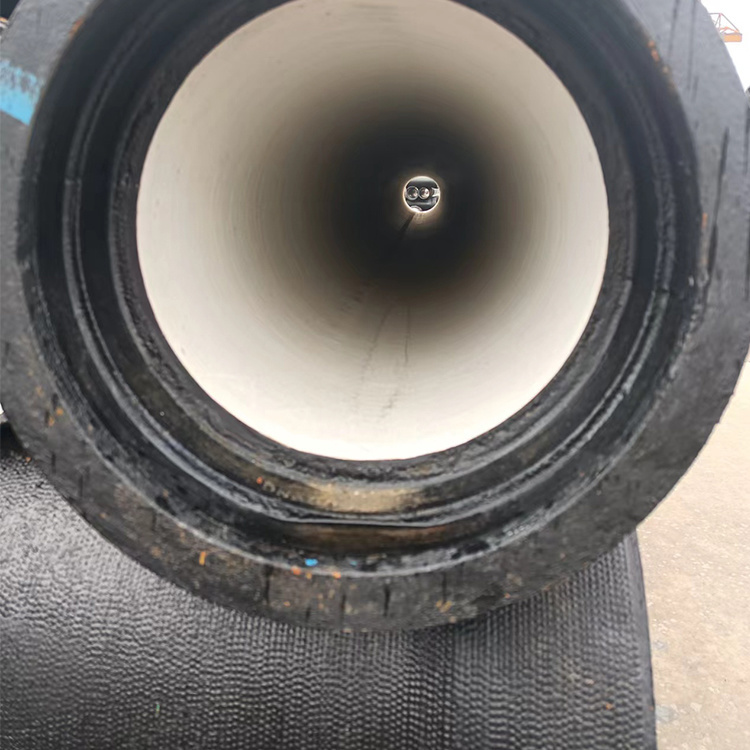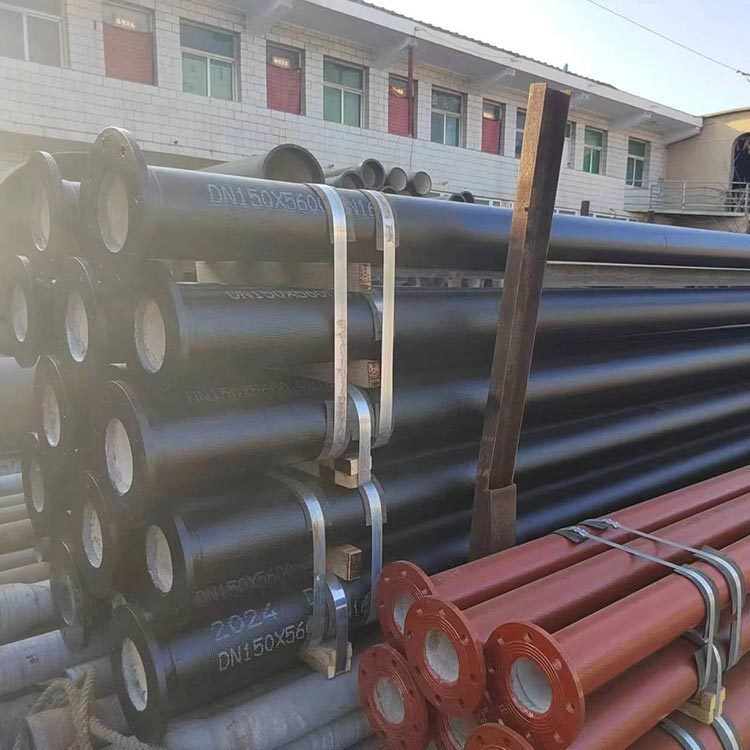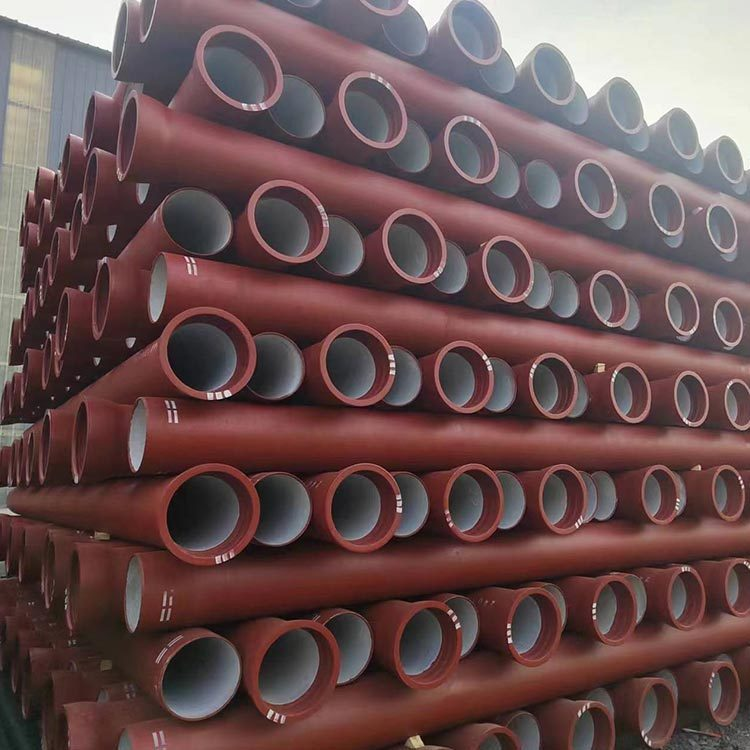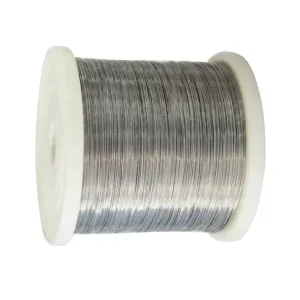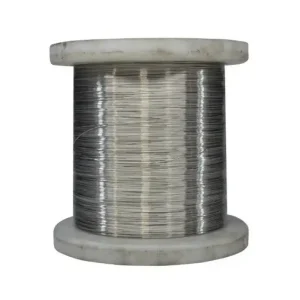K12 Ductile Iron Pipe (DIP) is a pressure-rated pipe system designed for water, wastewater, and industrial fluid transport. Its name combines:
-
"K12": Indicates the pressure class (12 bar/174 psi working pressure, tested at 24 bar).
-
"Ductile Iron": Refers to high-strength cast iron with added magnesium for superior flexibility (vs. brittle gray iron).
K12 Ductile Iron Pipe Specifications
| Parameter | Value/Range | Remarks |
|---|---|---|
| Nominal Diameter (DN) | DN80–DN2600 | Standard sizes; custom lengths available |
| Wall Thickness Class | K12 | Pressure rating: PN12 (12 bar working pressure) |
| Length | 5.5m, 6m (standard); Customizable | DN≥300mm typically shipped bulk |
| Material Composition | Ductile Iron (GGG-400/500) | Graphite spheroidization ≥90% |
| Tensile Strength | ≥420 MPa | Tested per ISO 6892-1 |
| Yield Strength | ≥300 MPa | |
| Elongation | ≥10% | |
| Hardness | ≤230 HB | Brinell scale |
| Internal Coating | Cement Mortar Lining (≥250μm) | ISO 4179-compliant; optional FBE/epoxy |
| External Coating | Zinc-Aluminum alloy (≥130g/m²) + Bitumen/Epoxy | Corrosion protection per ISO 8179 |
| Joint Type | T-Type (Tyton push-on), K-Type, Flanged | Allows 3°–5° deflection |
| Seal Type | SBR/EPDM Rubber Gasket | Pressure-rated for PN12 |
| Max. Working Pressure | 12 bar (PN12) | Test pressure = 24 bar (2×PN) |
| Burst Pressure | ≥42 bar (DN800 example) | |
| Operating Temperature | -30°C to +60°C | Suitable for frozen ground |
| Certifications | ISO 2531, EN 545, EN 598, GB/T 13295, WRAS | Potable water/sewage applications |
Material Composition and Mechanical Properties
K12 pipe is produced from grade EN-GJS-500-7 ductile iron, ensuring an average tensile strength of 500 MPa and elongation above 7%. This alloy resists mechanical stress and flow assurance issues. Moreover, nodular graphite microstructures give superior ductility and impact toughness.
| Property | Value | Test Standard |
|---|---|---|
| Tensile Strength (σᵤ) | ≥ 500 MPa | ISO 17804 |
| Yield Strength (σ₀.₂) | ≥ 325 MPa | ISO 17804 |
| Elongation at Break (A) | ≥ 7 % | ISO 17804 |
| Brinell Hardness (HB) | 170 – 230 HB | ISO 6506 |
| Modulus of Elasticity (E) | ≈ 170 GPa | ASTM A370 |
| Impact Toughness (Charpy) | ≥ 15 J at −20 °C | ISO 148‑2 |
| Pressure Rating (PN) | 16 bar (1.6 MPa) | ISO 2531 |
| Thermal Expansion Coefficient | 10.5 × 10⁻⁶ / °C | ASTM E831 |
Dimensions and Tolerances
Precision in manufacturing is paramount for pipeline integrity. Our K12 ductile iron pipes adhere to strict dimensional tolerances, ensuring seamless connections and optimal flow.
| Nominal Diameter (DN) | Outside Diameter (OD) [mm] | Wall Thickness (t) [mm] (Nominal) | Length [m] (Standard) |
| 80 | 98 | 6.0 | 6.0 |
| 100 | 118 | 6.0 | 6.0 |
| 150 | 170 | 6.2 | 6.0 |
| 200 | 222 | 6.5 | 6.0 |
| 250 | 274 | 6.9 | 6.0 |
| 300 | 326 | 7.3 | 6.0 |
| 350 | 378 | 7.7 | 6.0 |
| 400 | 429 | 8.1 | 6.0 |
| 450 | 480 | 8.5 | 6.0 |
| 500 | 531 | 8.9 | 6.0 |
| 600 | 633 | 9.7 | 6.0 |
| 700 | 735 | 10.5 | 6.0 |
| 800 | 838 | 11.3 | 6.0 |
| 900 | 940 | 12.1 | 6.0 |
| 1000 | 1042 | 12.9 | 6.0 |
| 1200 | 1246 | 14.5 | 6.0 |
| 1400 | 1450 | 16.1 | 6.0 |
| 1600 | 1654 | 17.7 | 6.0 |
| 1800 | 1858 | 19.3 | 6.0 |
| 2000 | 2062 | 20.9 | 6.0 |
| 2200 | 2266 | 22.5 | 6.0 |
| 2400 | 2470 | 24.1 | 6.0 |
| 2600 | 2674 | 25.7 | 6.0 |
Global Standards and Certifications
We comply with international and regional norms:
-
ISO 2531: Ductile iron pipes, fittings, accessories for water applications.
-
EN 545 / EN 598: Water supply and sewage systems.
-
AWWA C151: American standard for ductile iron pipe.
-
GB /T 13295: Chinese national standard.
-
WRAS Approval: UK potable water compliance.
Comparative Advantages
| Feature | K12 Ductile Iron Pipe | PVC Pipe | Steel Pipe |
|---|---|---|---|
| Burst Pressure | 16 bar | 10 bar | 20 bar |
| Ductility | High | Low | Moderate |
| Corrosion Resistance | Excellent (internal lining) | Good (external coating) | Requires frequent coating |
| Installation Speed | Moderate | High | Low |
| Lifespan | ≥ 50 years | 25–30 years | 30–40 years |
| Flow Assurance | Uniform bore | Smooth bore | Potential roughness |
Diverse Application Scenarios
The versatility of MWalloys K12 ductile iron pipes makes them suitable for an extensive range of applications, especially where reliability, durability, and resistance to harsh environments are paramount. We've seen our pipes deployed in numerous critical infrastructure projects, from bustling urban centers to remote industrial sites.
Where Our Pipes Excel:
- Potable Water Transmission and Distribution: This is perhaps the most common application. Our pipes ensure the safe and efficient delivery of clean drinking water from treatment plants to homes and businesses. Their internal lining prevents contamination and maintains water quality.
- Wastewater Collection and Conveyance: For sewage systems, our K12 pipes offer excellent resistance to corrosive elements found in wastewater, ensuring long-term integrity and preventing leakage.
- Irrigation Systems: In agricultural settings, these pipes provide robust solutions for water delivery over vast distances, resisting external pressures and offering leak-free performance.
- Industrial Piping: From process water to cooling systems in industrial facilities, the strength and chemical resistance of our ductile iron pipes make them ideal for demanding industrial environments.
- Fire Protection Systems: Given their high-pressure rating and durability, K12 ductile iron pipes are often specified for fire mains, providing reliable water supply for emergency services.
- Underground Utilities: Their inherent strength allows them to be buried directly in the ground, even under heavy traffic loads, without requiring extensive protective measures.
Installation Technical Specifications
Proper installation is critical to maximizing the lifespan and performance of our K12 ductile iron pipes. While specific project conditions will dictate precise methodologies, we can outline general best practices and technical considerations. We always recommend consulting the relevant international standards (e.g., AWWA C600, ISO 2531) and local regulations for detailed guidance.
Key Installation Stages:
- Trenching and Bedding:
- Trench Width: Ensure the trench is wide enough to allow for proper pipe laying, joint assembly, and compaction of bedding material. Typically, the trench should be at least 150-300 mm wider than the pipe's outside diameter on each side.
- Trench Stability: Maintain stable trench walls to prevent collapses. Shoring or sloping may be necessary depending on soil conditions and trench depth.
- Bedding Material: A stable, uniform bedding layer (e.g., compacted granular material like sand or fine gravel) should be prepared to support the pipe uniformly along its entire length. This prevents point loads and ensures even distribution of pressure. A minimum of 100-150 mm of bedding is usually recommended.
- Pipe Handling and Laying:
- Careful Handling: Ductile iron pipes are robust, but proper handling is crucial to prevent damage to coatings, linings, and bell ends. Use appropriate lifting equipment (slings, pipe hooks) and avoid dropping or dragging pipes.
- Alignment: Lay pipes with care, ensuring correct line and grade. Laser levels or traditional surveying methods can assist in maintaining alignment.
- Joint Assembly (Push-on Joints):
- Clean the spigot end and the bell socket.
- Apply lubricant to the spigot and the rubber gasket.
- Insert the gasket into the bell socket.
- Align the spigot with the bell and push the spigot into the bell until the witness mark on the spigot reaches the bell face. This typically requires mechanical force for larger pipes.
- Verify the gasket is correctly seated and uniform.
- Backfilling and Compaction:
- Initial Backfill: Place selected backfill material (free from rocks, debris, or frozen clumps) carefully around the pipe, compacting it in layers (typically 150-300 mm lifts) up to at least 300 mm above the pipe crown. This provides initial support and prevents pipe flotation during hydrotesting.
- Final Backfill: Continue backfilling and compacting the trench in layers up to the original ground level, using appropriate compaction equipment. The compaction method and density should align with project specifications and local regulations to prevent future settlement.
- Thrust Restraint:
- For pressure pipelines, thrust blocks or restrained joints are essential at bends, tees, reducers, and caps to counteract hydraulic thrust forces that could otherwise dislodge pipes. The design of thrust restraint should consider pipe diameter, pressure, soil conditions, and fitting geometry.
- Hydrostatic Testing:
- Once a section of pipeline is installed and backfilled (with thrust restraint in place), it must undergo hydrostatic testing to verify its integrity and detect any leaks. The test pressure and duration are specified by standards like AWWA C600 or project-specific requirements.
Best Practices & Considerations:
- Environmental Conditions: Consider weather conditions during installation. Extreme cold can affect gasket elasticity, while heavy rain can lead to unstable trench conditions.
- Safety First: Always prioritize worker safety. Implement proper trenching safety measures, utilize personal protective equipment (PPE), and ensure lifting operations are conducted safely.
- Quality Control: Regular inspections of pipe quality, joint assembly, bedding, and backfill compaction are crucial for a successful installation.
Frequently Asked Questions
1. What does "K12" signify in K12 ductile iron pipes?
The "K" in K12 refers to the pressure class or thickness class of the pipe. Specifically, K12 indicates a pipe with a nominal wall thickness sufficient to withstand a higher operating pressure compared to lower K-classes (e.g., K9). It signifies a robust design suitable for more demanding applications, especially those involving significant internal pressures or external loads.
2. How does the internal cement mortar lining protect the pipe?
The internal cement mortar lining, typically applied centrifugally, acts as a protective barrier against internal corrosion and tuberculation. It creates an alkaline environment that passivates the iron surface, preventing chemical reactions that lead to rust and material degradation. Furthermore, it provides a smooth surface, reducing friction losses and maintaining optimal flow capacity over the pipe's lifespan.
3. Are MWalloys K12 ductile iron pipes suitable for earthquake-prone areas?
Yes, our K12 ductile iron pipes, especially when equipped with flexible push-on joints, exhibit excellent performance in seismically active regions. The inherent ductility of the material allows it to absorb significant ground movement without brittle fracture. Moreover, the flexible joints can accommodate differential settlement and slight angular deflections, making them highly resilient to seismic forces.
4. What is the typical lifespan of a K12 ductile iron pipe?
MWalloys K12 ductile iron pipes are renowned for their exceptional longevity. With proper design, installation, and standard protective coatings and linings, they typically have a service life exceeding 100 years. Many installations globally have demonstrated continuous performance for well over a century, a testament to their enduring durability.
5. Can K12 ductile iron pipes be recycled?
Absolutely. Ductile iron is a highly recyclable material. At the end of its very long service life, ductile iron pipe can be melted down and repurposed, contributing to a circular economy and reducing the demand for virgin materials. This makes it an environmentally responsible choice for infrastructure projects.
6. What kind of maintenance is required for K12 ductile iron pipes?
One of the significant advantages of K12 ductile iron pipes is their low maintenance requirement. Once properly installed, they typically require minimal ongoing maintenance. Periodic leak detection surveys and standard pipeline integrity checks are usually sufficient. The robust external coatings and internal linings are designed for long-term performance without frequent intervention.


